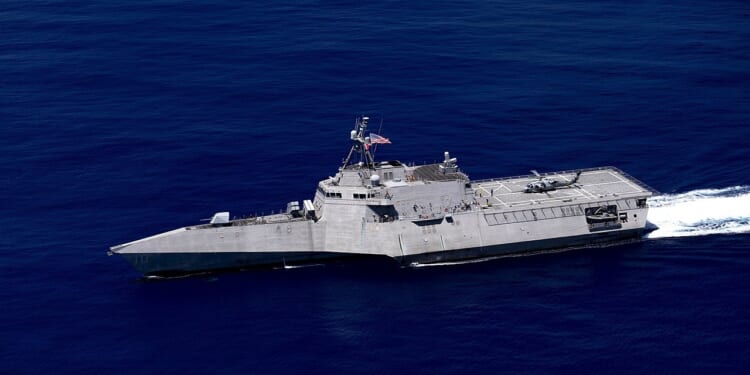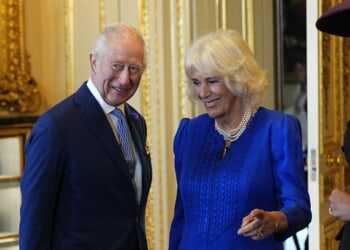The Independence-class LCS has been re-adapted for use as a minesweeper, although there are concerns that its aluminum hull might not be ideally suited for that purpose.
USS Pierre (LCS-38) departed from Mobile, Alabama, on Friday, a milestone for the warship but also for shipbuilder Austal USA. As reported by AL.com, the moment occurred with little fanfare—even as it marked the completion of the United States Navy’s Independence-class Littoral Combat Ship (LCS) program.
The Pierre—the second warship named for the capital city of South Dakota, after the PC-461-class submarine chaser that saw service during the Second World War, and the 19th ship of the LCS class—completed her sea trials in June. In July, the warship was officially handed over to the United States Navy and will be commissioned in Panama City, Florida, on November 15. Following the commissioning, USS Pierre will enter active service from her future homeport of San Diego, California.
Delivery of LCS-38 marked the end of the line for Austal, which has been building the small, fast-moving warships for the past 15 years. For the US Navy, it puts the capstone on a different story, as the service has struggled to find a role for ships in a changing geopolitical climate.
The Troubled History of the Littoral Combat Ship
The LCS program has been seen as one of the United States Navy’s biggest missteps since the end of the Cold War, perhaps only second to the Zumwalt-class destroyer.
Both the LCS and the stealth destroyers were seen as essentially the wrong ships at the wrong time. But while the US Navy cut the Zumwalt-class program to just three ships—placing its per-unit cost at an astronomical $4.24 billion, making it a very costly mistake—the sea service continued to accept delivery of brand new LCS vessels, even as the two oldest were retired years ahead of schedule.
The US Navy had previously announced plans to decommission as many as two more LCSes, with the intention of selling them to other countries. However, it later changed course as it found a new role for the Independence-class LCS. Originally designed as multipurpose adaptable warships capable of being equipped with mission-specific weapons modules and operating in littoral or near-shore waters, the Independence-class has proven to be reasonably suited for serving as minesweepers.
Fitted with a Mine Countermeasure Mission Package (MCM MP), a suite of unmanned maritime sensors that were developed to locate, identify, and destroy mines in littoral waters, the Independence-class LCS will replace the aging Avenger-class mine countermeasure vessels between 1987 and 1994.
It was an example of finding a problem for an existing solution, and it remains to be seen if the LCS vessels will be the right tool for the job. For one thing, the trimaran hulls of the LCS are made of aluminum, whereas the Avenger-class hulls were constructed of wood, including oak, Douglas fir, and Nootka Cypress, and sheathed with fiberglass. The seemingly anachronistic choice of materials was deliberate, because a wooden hull has little magnetic signature. Aluminum also lacks the magnetic signature of ferromagnetic materials such as iron, but as a paramagnetic material, it can exhibit a temporary signature in some instances.
That also explains why the Freedom-class LCS variants, designed and built by Lockheed Martin at the Fincantieri Marinette Marine, may not serve in a minehunting role, as the hulls of those models are made of steel.
Not the End of the Line for Austal USA
The now-retired USS Independence (LCS-2) was the first LCS ship of the class built at Austal USA’s facilities in the Port City. Laid down in April 2008, she was completed two years later.
The program has seen the workforce grow from around 1,000 employees to approximately 4,500.
With the completion of the LCS-38, the shipyard will transition to building the Navajo-class Towing, Salvage, and Rescue (T-ATS) ships for the US Navy, as well as the Saildrone unmanned surface vessels (USVs). The company is also contracted to build the military’s future Expeditionary Medical Ships, and continues to build modules for the Virginia-class and future Columbia-class nuclear-powered submarines.
About the Author: Peter Suciu
Peter Suciu has contributed over 3,200 published pieces to more than four dozen magazines and websites over a 30-year career in journalism. He regularly writes about military hardware, firearms history, cybersecurity, politics, and international affairs. Peter is also a contributing writer for Forbes and Clearance Jobs. He is based in Michigan. You can follow him on Twitter: @PeterSuciu. You can email the author: [email protected].
Image: Wikimedia Commons.


















